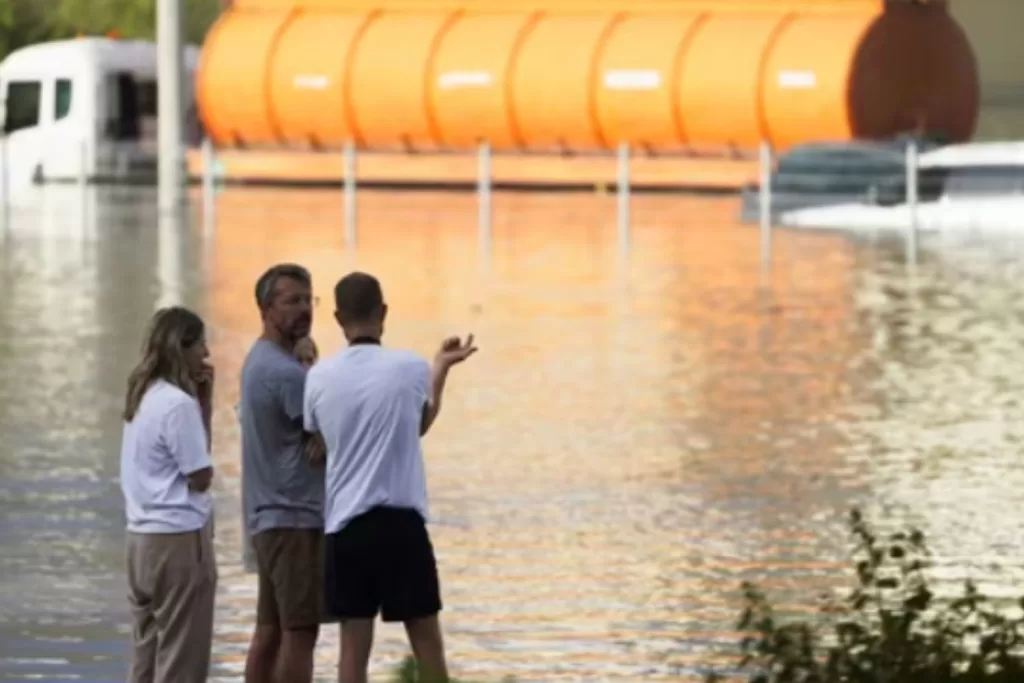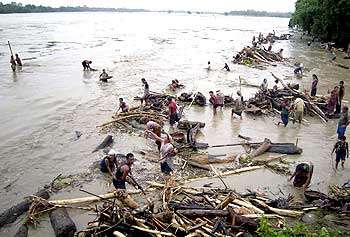Dubai Floods: Airport Chaos, Flights Disrupted, City Grapples
Dubai, known for its desert landscapes and sunny skies, faced an unexpected challenge as heavy rainfall swept through the city. The UAE government took action, issuing warnings for people to stay indoors unless absolutely necessary.
On Tuesday, the rain hit hard, turning Dubai's major highways and even the international airport into waterlogged areas. Flights were temporarily halted for 25 minutes as water covered the runways, an unusual sight in this typically arid city.
Social media buzzed with images of planes navigating through flooded tarmacs at the airport, showcasing the intensity of the downpour. Meteorological data from Dubai International Airport revealed something astonishing – the city received a year and a half's worth of rain in just 24 hours!
It all started on a Monday night when the rain began, showering Dubai with around 20 millimetres (0.79 inches) of rain. By Tuesday evening, this had escalated to a whopping 142 millimeters (5.59 inches) – far beyond the usual annual average of 94.7 millimeters (3.73 inches).
So, what caused this deluge in the desert?
CNN reported that a massive storm system sweeping across the Arabian Peninsula was to blame, making its way over the Gulf of Oman. This same system also brought heavy rain to Oman and southeastern Iran, causing significant disruptions and unfortunately, loss of life.
Friederike Otto, a climate change expert, shed light on the role of global warming in this extreme weather. She mentioned that climate change likely made the rainfall in Dubai and Oman heavier and more destructive.
Interestingly, the UAE has been using a technique called cloud seeding since 2002 to enhance rainfall and address water security concerns. Cloud seeding involves injecting chemicals and tiny particles, like potassium chloride, into clouds to stimulate rain production.

Ahmed Habib, a meteorologist, explained that cloud seeding missions were active during these heavy rains, with planes conducting seven missions in just two days. This practice partly contributed to the intensified rainfall, as reported by Bloomberg.
In summary, a combination of a massive storm system, global warming, and cloud seeding operations led to the extraordinary rainfall that flooded Dubai, highlighting the city's vulnerability to unexpected weather events.
Airport Flooded, Schools Closed, and Traffic Standstill
Unprecedented rainfall in Dubai has caused chaos across the United Arab Emirates, leading to widespread flooding in the desert nation. Dubai's major international airport was forced to divert many incoming flights on Tuesday, April 16th, with destinations like India, Pakistan, Saudi Arabia, and the UK affected.
The torrential rain, which even led to the suspension of Dubai International Airport's operations briefly, was partly due to cloud seeding. The airport, one of the busiest in the world, had been anticipating over 100 flight arrivals on that Tuesday evening, but the storm disrupted plans.
Departure flights, however, continued with delays and cancellations, and access roads to the airport were severely flooded. Flydubai took the step to suspend all its flights departing from Dubai until Wednesday morning due to the bad weather, as reported by the UAE state news agency WAM.
The scenes of flooding were not limited to the airport; Dubai's iconic shopping centers like Dubai Mall and Mall of the Emirates were also affected. Social media was flooded with videos and images of cars being swept away, a shop's ceiling collapsing due to water, and ankle-deep water in a Dubai Metro station.
Torrential rain in Dubai has caused major disruptions, including flooded roads and the diversion of flights. https://t.co/9oapfZwyQg
— Hindustan Times (@htTweets) March 18, 2024
The situation caused significant disruptions, with schools shutting down, traffic coming to a standstill, and even the postponement of the Asian Champions League football semi-final between UAE's Al Ain and Saudi's Al Hilal.
Dubai, known for its arid climate and intense heat, found itself grappling with an unusual natural event. Both Oman and the UAE, having recently hosted the COP28 UN climate talks, have been warning about the increased likelihood of such extreme weather events due to global warming.
The stormy weather also affected other parts of the UAE and Bahrain, with tragic consequences in Oman where 18 people lost their lives. The impact of this unexpected rainfall will be felt for some time, as communities work to recover from the aftermath of the floods.
Click for more updates and the latest world news, along with Web stories updates. Also, get the latest news and top headlines from India and around the world at Speed News





